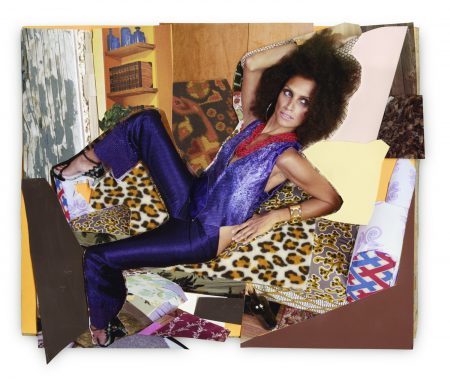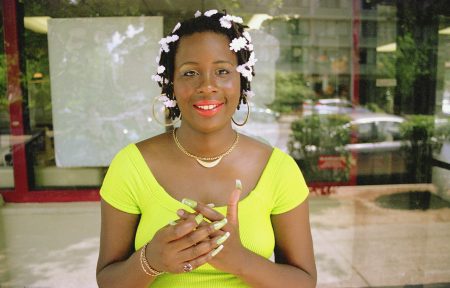Lookin’ for some hot stuff, baby this evenin’
I need some hot stuff, baby tonight
I want some hot stuff, baby this evenin’
Gotta have some hot stuff
Gotta have some love tonight

Courtesy of the artist, Lehman Maupin, New York and Hong Kong; and Artists Rights Society (ARS) New York
Donna Summers sang it and Sandra Bush danced and romanced to it and Sandra’s daughter Michalene turned it into art.
Mickalene Thomas, a contemporary African-American artist best known for her complex paintings made of rhinestones, acrylic, and enamel, was born in Camden, New Jersey and was raised by her mother. Fortunately Sandra exposed Mickalene and her brother to art by enrolling them in after-school programs at the Newark Museum, and the Henry Street Settlement in New York. Thomas received her BFA from Pratt Institute in 2000 and her MFA from Yale School of Art in 2002. Her work draws from Western art history, pop art and visual culture to examine ideas around femininity, beauty, race, sexuality, and gender.
Mickalene Thomas’ muse was her own mother, a very stylish and hip woman who, at 6’1″ tall, modeled in the 1970s. Thomas’ mother Sandra Bush’s career was eclipsed when a leading fashion photographer brought Iman to the United States from Africa. Bush simply could not compete with the stunning beauty of Iman. This is all presented with love and candor in the video Thomas created as a conversation between her mother and herself. The video also calls up her parents’ addiction to drugs and Thomas dealing with her sexuality, which she documented in the short film Happy Birthday to a Beautiful Woman: A Portrait of My Mother on view in this exhibition.
While Thomas is acclaimed for her large-scale collage-like paintings, she liberally uses small collages as a starting point which she makes from cut up photographs of black women often lounging in 1970’s interiors, the era of Curtis Mayfield and Superfly. The aesthetic of black beauty, African roots, fabric patterns and black culture resonate throughout these collaged tableaux. They in turn lead to large-scale paintings that have the same fresh look of collage and are often richly embellished with rivers of rhinestones.
With Thomas’ reliance on photographic sources for her arresting black women, Thomas naturally turned to pure photography as an important element in her oeuvre. In her photography, the number of muses now expands beyond her mother, the former languid and long-legged model. Mickalene turns the camera to various friends, and lovers. She also takes tender self-portraits, not as a vamp, but as a fully formed woman in our more permissive culture, which allows for the full expression of lesbian desire.
Muse is the first exhibition to gather together her various approaches to photography. The exhibition is organized by Aperture Foundation, New York. Apeture is the premier society for the support of photography in America. Further, this exhibition is presented in conjunction with Cincinnati’s FotoFocus Biennial; the Dayton Art Institute is a participating venue of this year’s FotoFocus Biennial. “Mickalene Thomas highlights the importance of representation by creating positive images of black and lesbian women within art history—images that are sorely lacking,” says Katherine Ryckman Siegwarth, The Dayton Art Institute’s in-house curator for the exhibition. “Through various references and visual motifs, Thomas challenges the standards of beauty that exclude blackness and female autonomy.”

Courtesy of the artist, Lehman Maupin, New York and Hong Kong; and Artists Rights Society (ARS) New York
Mickalene Thomas’ Negress with Green Nails from 2005 is a self-portrait of utmost delicacy and beauty. Thomas is not a model as her mother-muse was; yet here is such a tender look of confidence, but not over-confidence. Sincerity but not mawkishness. Thomas is wearing white flower-shaped barrettes in her hair that form a ring around her face like an ancient Greek maiden perhaps. Her crazy long chartreuse nails form a fan of artifice and beauty in front of her body. She likely has just come out of a nail salon. The background is a mall. This has the same vibe as Kerry James Marshall’s magnificent School of Beauty, School of Culture of 2012, not in its scale and complexity of course, but in its shared focus on what is beautiful in black culture. It is distinctly not what you see on the cover of Vogue.
The exhibition of nearly fifty photographs include such straightforward photographic portraits such as I described above, along with small photo-collages that reveal Thomas’ working methods as they apply to her well-known large-scale paintings. In seeing both types of works, one has a full grasp of the intelligent and thorough working methods Thomas employs. Her photography has been featured in recent issues of Harper’s Bazaar, W Magazine, and T: The New York Times Style Magazine. Her portrait of Michelle Obama was the first individual portrait done of the First Lady and was exhibited in the National Portrait Gallery‘s Americans Nowshow.
The Dayton exhibit also includes one of Thomas’ installations of a 1970’s setting such as Thomas creates sometimes when she poses and photographs her models. The installation has a couch, side tables, lamps, fake plants, 1970’s album records stacked on the carpeted floor; a time capsule back to the 1970’s to call up the black-is-beautiful era. It is not original like Terry Allen’s Texas border cantina or Jason Rhoades takes-over-all-the-space-floor-to-ceiling installations, but it reinforces the starting point of Thomas’ art work. That starting point is her first muse- her mother’s mileau. Besides, Thomas is primarily a painter so her installations are not her main gig.
Generously, Thomas curated a small exhibit she calls tête-à-tête which is part of this exhibition. Thomas has selected ten artists whose own practice has informed hers. All the art works are small in scale and fit within the overall framework of exploration by artists of color. The artists include Renee Cox, LaToya Ruby Frazier, Zanele Muholi and Carrie Mae Weems.
Thomas gives us the whole picture and it is beautiful.
Admission to Muse: Mickalene Thomas Photographs and tête-à-tête is free for museum members. Non-member admission is $14 adults; $11 seniors (60+), students (18+ w/ID), active military and groups (10 or more); $6 youth (ages 7–17); and free for children (ages 6 & under). Prices include admission to Muse: Mickalene Thomas Photographs and tête-à-tête, as well as the museum’s collection galleries. As one of the Miami Valley’s premier fine art museums, The Dayton Art Institute offers a full range of programming in addition to exhibiting its collection. Gallery hours are Wednesday–Saturday, 11 a.m.–5 p.m., and Sunday, noon–5 p.m., with extended hours until 8 p.m. on Thursdays. Suggested general admission to the museum’s collection galleries is $8 adults, $5 seniors, active military and groups. Admission is free for museum members, students (18+ w/ID) and youth (17 and under). Some special exhibitions, programs and events may carry an additional charge and include admission to the museum’s collection galleries as part of that price. Free parking is available at the museum and the facility is fully accessible to physically challenged visitors. The DAI’s Museum Store and Leo Bistro are open during regular museum hours. For more information, visit daytonartinstitute.org or call 937-223-4ART (4278).
Always refreshing when photographs reveal genuine meaning and thought rather than merely latest digital smoke and mirrors which have become so commonplace.